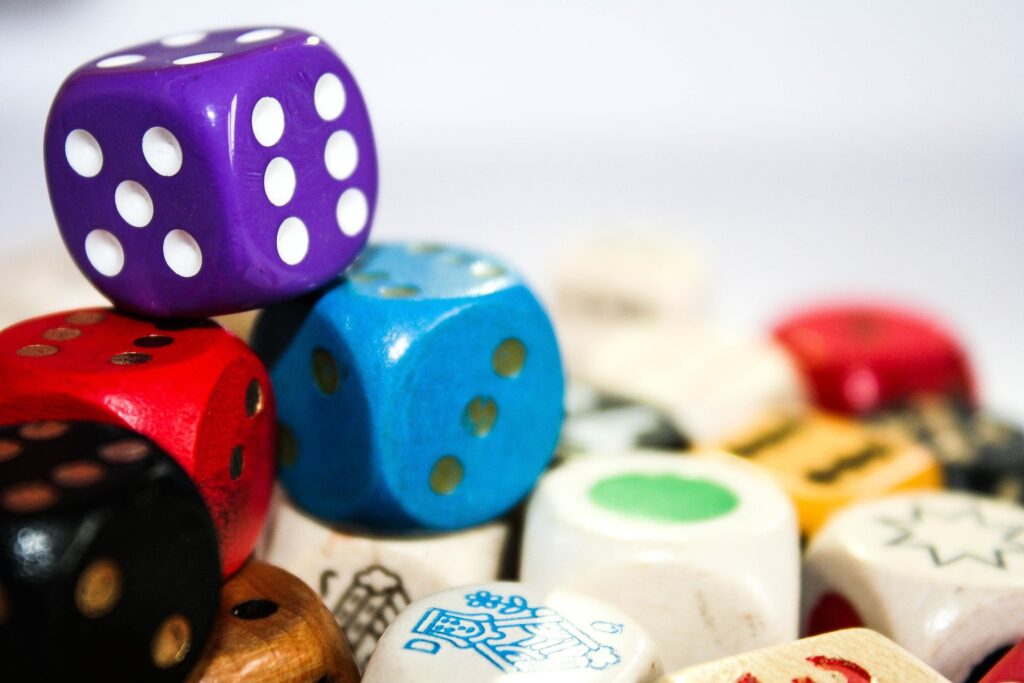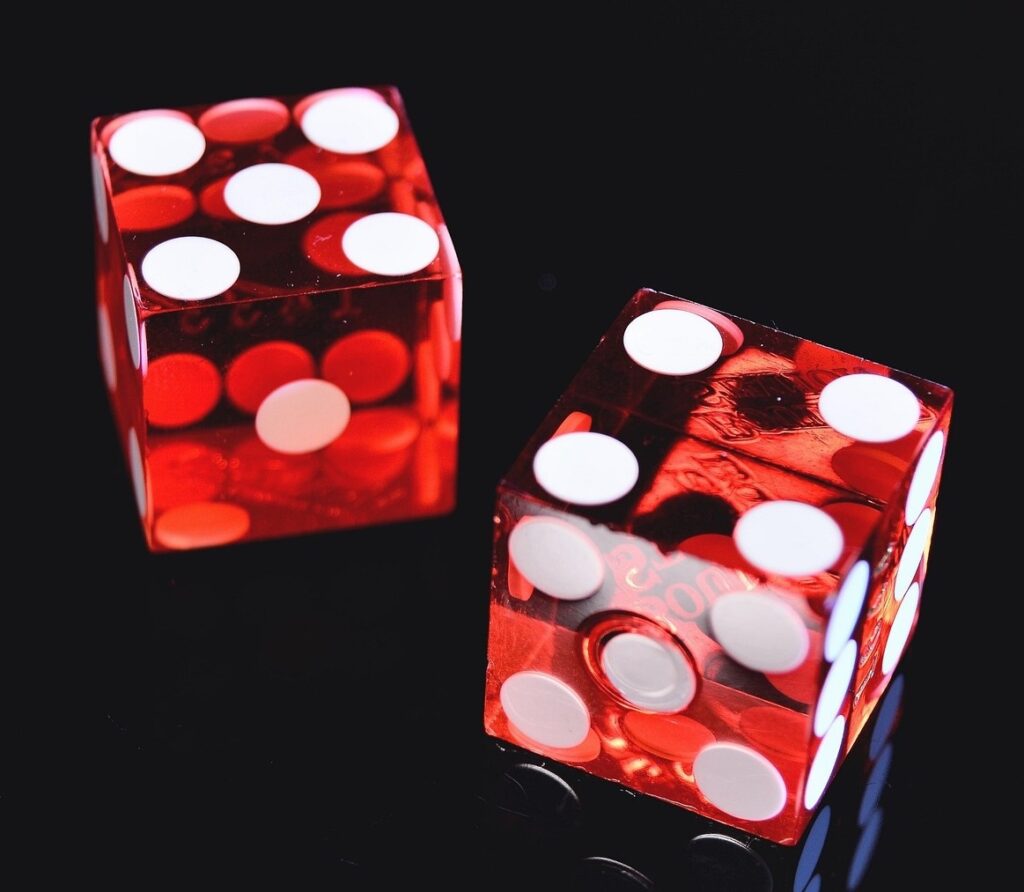Dicing With Maths
BLOG: Heidelberg Laureate Forum


For thousands of years, humans have used dice in games of chance – from ancient Egyptian two-sided throwing sticks, to rudimentary dice made from animals’ knucklebones, through to the carefully weighted precision dice used in modern casinos. While they are tiny objects, the roll of a die can mean fortune or ruin, and – as you might have guessed – I am very pleased to report that there are also many mathematically interesting things about dice too.
Cube Roots
The standard modern die is a six-sided cube, with the numbers 1-6 distributed amongst its sides, often in the form of pips (dots). This design dates back as far as ancient Rome, where six-sided tesserae were used in gambling games. A cube is a familiar shape, with regular faces all the same shape, meeting in corners that all look identical – one of the five platonic solids, as I discussed in a blog post back in 2018.
But it is not the only shape that is used for dice. Many people associate a range of interestingly-shaped dice with tabletop role-playing games like Dungeons & Dragons (D&D), in which decisions are made about the success or failure of the players’ (and their enemies’) actions by the roll of a die.
Since always having six possible outcomes would be too restrictive, the game as published in 1974 incorporated a range of dice, from tetrahedral four-sided dice (known as D4s) through to icosahedral D20s, often used for determining whether an attempted action has been successful. D4s, D8s (octahedral) and D12s (dodecahedral) are often used for determining the amount of damage done by different sizes of weapon, with larger weapons using the larger dice.
Ten-sided dice, based on a shape called a deltohedron made from ten kite-shaped faces which meet at a wavy line around the edge and at two points, are often employed when the players need to determine a percentage (using two dice, one marked with multiples of ten from 00-90, and another with units 0-9).
However, modern roleplayers weren’t the first to use such dice: D20s actually date back as early as 200 BCE, and were used in Ptolemaic Egypt and ancient Rome for gaming and divination, with examples of glass and stone dice including this one in the Met museum’s collection.
The shapes used for D&D dice are all examples of isohedra: shapes with identical faces. This is because the crucial property of a die is fairness: it is important that when it is thrown, the chances of landing on any one of the faces is equal. This becomes especially important when dice are used in high-stakes situations like casinos, where huge amounts of money are at stake and any chance of cheating must be stamped out.
All the Fun of the Fair
The standard design for a six-sided die aims to balance the chances of it landing on a small or large number by the arrangement of the numbers on the faces – opposite faces on a six-sided die will most often add to 7, with 1 opposite 6, 2 opposite 5 and 3 opposite 4. (This fact means Ben Sparks can perform a fun magic trick using three standard dice.) Beyond this requirement, there is not much else that is standard – even this allows for two non-equivalent (but mirror-symmetrical) versions of a D6, on top of which you can orient the numbers or arrangements of dots in a variety of different ways, all of which can be found in commercially available examples.
Dice for use in casinos are carefully manufactured: while ordinary dice you might buy in a shop will have holes drilled in each face for the pips, with a little paint inside to make them visible. Given that some faces have more holes than others, this will certainly make the dice incrementally less fair than they were before holes were drilled. Casino dice have their pip holes, which are precision drilled, entirely filled in with paint which is chosen to match the density of the material the dice are made of. They are a perfect cube, often manufactured to a tolerance of 0.0005 inches – because they need to be 100% fair.
I am pretty pleased about this, since the fairness of dice also means I can make mathematical calculations about the probability on the assumption that each of the six faces of a standard die come up ⅙ of the time, and on this basis they are popular for teaching school children about simple probability concepts.
In fact, once we understand that the purpose of dice is just to be an object which lands on each face with an equal probability, this opens up more possibilities for dice with different numbers of faces. For example, a sphere could be considered a 1-sided die, since whichever way up you throw it, it will always land on its one outside face. It is also possible to create 5-sided dice, using a triangular prism of the right length so that the probability of landing on each of the three rectangular sides matches the probability of landing on each triangular face.
Stand-up mathematician Matt Parker considered the question of a 3-sided die in this YouTube video a few years ago. Some might consider a two-sided die to be a coin, but there is always a chance – even if an incredibly tiny one – that it will land on its edge. In that case, how thick does the coin have to be before the probability of landing on the edge matches the chances of landing on each face? I’ll leave you to watch the video to find out.



Katie Steckles wrote (08. Mar 2023):
> […] Ten-sided dice, based on a shape called a deltohedron made from ten kite-shaped faces which meet at a wavy line around the edge and at two points, […]
While ‘t might be nobler in the mind to suffer silently, fairness cries out to have the ten kite-shaped (four-sided) faces of a (regular) Deltohedron to meet (pairwise) explicitely in all twenty of its edges
(with three faces, resp., each meeting at one of ten of its vertices; and even five faces, resp., each meeting at one of its remaining two vertices).
> […] versions of a D6 [with] arrangements of dots in a variety of different ways, all of which can be found in commercially available examples.
With four pips arranged in the shape of the four vertices of https://de.wikipedia.org/wiki/Datei:K4_planar.svg on one D6 face, too ??
Der wie hier gemeinte sechsseitige Würfel, der beforscht werden kann oder könnte, wenn er eben “gezinkt” (ein nicht zu unterschätzendes Problem im Backgammon, Dr. W sich hier auskennen tun, dort liegt direkt wie gemeinte Problematik vor) sein könnte, ist ein sozusagen natürliches statistisch-stochastisches Subjekt der Forschung.
Der mathematischen wie der physikalischen.
Auch bei zwei-seitigen Würfeln und deren Betrachtung rät Dr. Webbaer an keine Drittseitigkeit, keinen sozusagen Schroedinger-Würfel zu suchen.
Ansonsten. also wenn so gesucht und vor allem auch gefunden werden sollte, stände Dr. Webbaer auch mit diesbezüglicher Einschätzung, also Nachricht parat.
Just saying….
Dr. Webbaer
Dr. Webbaer schrieb (08.03.2023, 18:51 o’clock):
> […] Auch bei zwei-seitigen Würfeln und deren Betrachtung
… wobei Gedanken an Münzen und Münzwürfe naheliegen mögen …
> rät Dr. Webbaer an[,] keine Drittseitigkeit, keinen sozusagen Schroedinger-Würfel zu suchen.
Dem lässt sich nachhelfen:
Eine aus der Hand hoch geworfene Münze lässt sich ja (z.B.) mit der anderen Hand, sofern vorhanden, ggf. mit einem lauten, an Endgültigkeit gemahnenden Klatsch, zurück auf die ausgestreckte Wurf-Hand-Fläche kloppen.
(Und manche könnten dabei auch mehr “Geschick beweisen” bzw. — in ihrem jeweiligen Sinne — mehr “Münzwurf-Erfolg verbuchen”, als manche andere. …)
Vergleichbar im Katzensujet lässt sich die Haustür eben ganz rabiat aushängen oder eintreten, und die Katze würde dadurch (rein thermodynamisch pausenlos) gezwungen, auf Leben und Tod zwischen Drinnen und Draußen Hin-und-Her-zu-Flippern — bis wohl nicht mehr viel davon übrig wäre.
(Just giving the lady the old tour of the salt mines … &)
Physikalisch, wie auch gedanklich, ist es nicht möglich einen sozusagen perfekten Würfel zu entwickeln.
Vgl. hiermit :
Wobei die mögliche “Zwischenlandung” auf der Kante nebensächlich ist, durch Wiederholung und Wiederholung von Wiederholung ersetzbar bliebe, theoretisch und mathematisch-theoretisch sozusagen.
Dies liegt daran, dass es keine Definition von perfektem Zufall geben kann.
Bemüht wird sich hier, mathematisch, aber letztlich läuft es doch auf diesen sozusagen anarchistischen Gag eines (mittlerweile diskontierten, “gecancelten”)) Intellektuellen hinaus :
-> https://www.random.org/analysis/dilbert.jpg
HTH (“Hope this helps”)
Dr. Webbaer